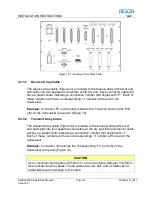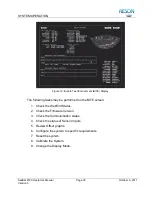
SYSTEM OPERATION
SeaBat 8160
Operator‟s Manual
Page 30
October 6, 2011
Version 5
5.5 Ocean Menu
The Ocean menu allows for the entry of various correction factors to compensate
for changing environmental conditions. With this menu, the operator can:
1. Change the Spreading Loss Coefficient
2. Change the Absorption Loss Value
3. Set the Sound Velocity
5.5.1 Change the Spreading Loss Coefficient (Spread)
This selection allows the operator to enter the amount of cylindrical and spherical
Spreading Loss that is expected through the ambient water medium. The range
available is from 0 to 60, with a recommended initial value of 30.
This coefficient value is used in conjunction with the Absorption Loss value (see
section 5.5.2 Change the Absorption Loss Value (Absorb)
) to compute the TVG
curve applied to the returned signal (see
section 5.4.6 Change the Gain Mode
5.5.2 Change the Absorption Loss Value (Absorb)
This selection allows the operator to enter the amount of loss expected through
the ambient water medium. The range available is from 0 to 120dB/km. If the
exact value is not known, a value of 13dB/km for salt water and 2dB/km for fresh
water is recommended.
This value is us used in conjunction with the Spreading Loss Coefficient to
compute the TVG curve as described in
section 5.5.1 Change the Spreading
5.5.3 Set the Sound Velocity (Velocity)
The “Velocity” item displays externally measured the speed of sound through the
local water. The value is represented in meters per second, and is used in range
display and receiver beam steering.
This setting can only be modified if a sound velocity probe is not interfaced to the
system. The range allowed is from 1350 to 1600m/sec. If the local sound velocity
is not known, RESON recommends a value of 1480 to 1500m/sec for open sea
areas and 1425m/sec for fresh water. See
typical surface sound velocity at different temperatures and salinity.
















































